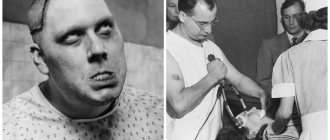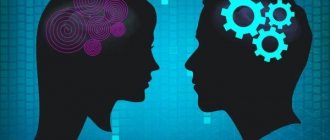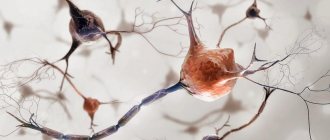About the gap between the hemispheres
A gap between the hemispheres must be present, but its dimensions cannot exceed 3 mm. If it is slightly enlarged, then we can talk about the anatomical features of the child’s development.
The disease is indicated by a condition when the interhemispheric fissure is widened and filled with fluid. Often, the baby is diagnosed with diseases such as rickets, hydrocephalus or intracranial pressure. But doctors do not make a diagnosis based on neurosonography; the clinical picture is also important. This condition is also called dilatation. Sometimes the anomaly is detected immediately in the maternity hospital; it also happens that parents detect suspicious symptoms by the 5-6th month of the child’s life.
During the examination of the newborn, the doctor will ask the parents questions such as:
- What is the baby's sleep like, how many hours a day, what are the wakefulness intervals, etc.
- Regurgitation frequency.
- Is the child calm, does he have hysterics that last more than 5 minutes.
- Questions regarding the baby’s reflexes, how he reacts to changes in temperature, flashes of light, loud sounds.
- When a doctor examines a child for the presence of rickets, the disease may be indicated by an enlarged fontanel, a wide forehead and a smooth nape with worn-out hairs.
Neurosonography can reveal abnormalities in brain function, but the results of this study must be correctly deciphered.
The doctor also measures the circumference of the head, which makes it possible to suspect hydrocephalus, the color of the skin, the presence of a marbled pattern, checks the fontanel and eyes for the absence of strabismus or Graefe's syndrome (in which the child's eyes roll up so much that the whites are visible).
In what cases is urgent consultation with a doctor necessary?
You will need to contact a neurologist soon if your baby has the following symptoms:
- poor sleep;
- if the child is often very excited;
- he is frightened by sharp sounds, which leads to crying or screaming;
- severe fountain vomiting;
- squint or different pupil sizes appeared;
- head circumference increased more than normal;
- protrusion and slow overgrowth of the fontanel;
- eyes bulge or roll back in such a way that only the whites are visible;
- convulsive condition, or regular twitching in the chin, arms or legs;
- the nose often bleeds;
- skin marble pattern;
- with changes in atmospheric pressure the child becomes restless.
In this case, an enlarged interhemispheric fissure in children requires specific treatment.
Interhemispheric connections - what is it?
The human brain, as we know, consists of the right and left hemispheres. Each of them is responsible for different functions. Left - for logical thinking, analysis, mathematics ability, speech. Right - for the ability to plan, imaginative thinking, creativity, listening to information. For the brain to function properly, both hemispheres must be equally developed.
Functions of interhemispheric connections:
- emotional stability to negative factors;
- coordination of movements;
- successful assimilation of information and its analysis.
When the connection between the hemispheres of the brain is weak, the stronger one takes the leading role, therefore, the functionality of the other is blocked. This leads to the fact that the child experiences disorientation in space, it is difficult for him to learn to write and read, visual and auditory perception is impaired, and possibly an inadequate emotional response to various life situations. As a result, the child has difficulty mastering educational material and becomes suspicious.
When to treat?
But often the expansion of the interhemispheric fissure is accompanied by concomitant diseases, in which case medications are prescribed to eliminate this pathology.
So, if there is rickets and the child lives in an area with little sunlight, medications containing vitamin D will be prescribed.
If intracranial pressure is detected, then weak diuretics are prescribed, which promotes the rapid outflow of fluid from the hemispheres. You will also need drugs like Asparkam or Diacarb, which contain potassium, to prevent hypokalemia and hypomagnesemia. An indicator of the baby's health will be his good health.
If neurological disorders are present, then you will need to take vascular medications to improve cerebral circulation (Actovegin, Cerakson) and sedatives at night (Bayu-Bai, Sleep Formula, Dormikind).
What to Expect
According to statistics, 80% of newborns experience neurological disorders, which do not pose a particular threat to health and disappear over time without consequences. But there are incompetent doctors who, without understanding the situation, rush to make a terrible diagnosis.
For example, when the interhemispheric fissure widens, some doctors assure the child’s parents that he has increased intracranial pressure. But these two diagnoses are not always present simultaneously. It is worth understanding that intracranial hypertension is a serious disease that requires special treatment. Therefore, it is impossible to make such a serious diagnosis as ICP based on the detection of expansion of the cerebral hemispheres.
Neurosonography can answer many questions, but not all, and therefore, if the doctor makes a serious diagnosis based on this study, parents should request additional examination of the baby.
Neurosonography - what is it?
The best method for diagnosing the expansion of interhemispheric bones is neurosonography. This process is the same ultrasound examination (ultrasound), but only targeted and more aimed at studying the structures of the brain and everything connected with it. It provides a unique opportunity to study the internal space of the baby’s skull, establishing the degree of divergence of his head bones.
The bottom line is that ultrasound allows us to draw conclusions regarding the presence of certain pathologies in the baby’s skull associated with the discrepancy of the bones at the crown. Abnormalities detected by ultrasound include even those that were detected at the very beginning of a child’s life, while still in the womb.
Interhemispheric fissure in infants: normal indicators, diagnostic methods
As already mentioned, the size of the gap should not exceed 3 mm. This is the norm for the interhemispheric fissure. Indicators from 3 to 4 mm remain in the child for up to 6 months.
Diagnosing the disease in babies under one year of age is difficult, since many methods are not used for this age. The most informative method is neurosonography. This procedure appeared not so long ago, only in the 90s of the last century.
Neurosonography resembles ultrasound; thanks to the existing fontanelles, the intracranial space can be more thoroughly examined. The sensors must first be lubricated with a special gel, and then applied to the soft spots on the baby’s head. Thanks to the transmitted ultrasound, it is possible to determine the presence or absence of pathology, as well as find out whether there is an interhemispheric fissure in the brain. The advantage of this study is its accessibility, it does not require preliminary preparation, and most importantly, the method is quite informative.
dilatation of the interhemispheric fissure
...I experienced the most wonderful feeling when MY DREAM was on my chest... I imagined so many times what SHE would be like... how happy we would be... how we would love HER... I always wanted a DAUGHTER! And SHE makes me happy every day))) How I love my Princess!!!!))) So, before I forget... For the story:
HOSPITAL QUESTIONS:
On April 10, we took a urine and blood test.
On April 12 we had an appointment with the pediatrician. Weight 6100 (+2788), height 61.5 (+7.5). The analyzes are “perfect”!!! The throat is reddish and runny. They said “No teeth planned”!!! How? Where did we catch a cold then??? And all the symptoms are like teething (fever, loose stools, moodiness, runny nose, swollen gums). In general, we were prescribed Derinat 5 times a day, 1 drop in each nostril for 5 days, Tantum Verde with a pipette from a spoon (spray on a spoon) for 3 days. We received a ticket to see a neurologist.
13.04 - neurologist: there is a little tone in the legs and half of the neck remains... They prescribed a tonic massage for the back muscles + paraffin-ozokerite application “high boot”. We will do it at home again. They also recommended swimming and gymnastics on a ball, which we have been doing for a long time.
On April 15, we booked a vaccination at Tanara (family clinic). We decided to make it paid. I felt very sorry for my daughter with a fever, so I didn’t want a repeat...
On April 16, we went to the pediatrician, received “permission” to get vaccinated (the throat is NON-RED, there are fewer sniffles!!!) We did Imovax in the PC, then we went and got Infanrix. The reaction was surprisingly normal: very few whims and a temperature of 37.1 at 23.00, when we went to bed. The leg doesn't seem to be swollen TTT.
On April 17 we went for an ultrasound of the head. As a result, the conclusion: “Echo signs of hypertension syndrome (slightly pronounced). Dilatation of the interhemispheric fissure is slightly pronounced.” Doppler: resistance index in the anterior cerebral artery 0.68 (normal 0.58-0.67). As the doctor explained, this means that there may have been hypertension, or ICP. It’s understandable, because during my QUICK labor (3 hours) there was a STRAIGHT SINGLE WINDING => HYPOXIA... Damn(((But there is nothing criminal, you need to contact a neurologist. “Nothing serious, but not ideal.” Perhaps everything will work out even without treatment! I recommended doing a control in 3-6 months (before the fontanelle closes) We will consult a neurologist!!!
I myself made an appointment with a gynecologist on April 25... Yes, yes, I haven’t been yet ((( I hope everything will be great!!! I want to figure out the issue with birth control. Of course, we’ll “go” for the second one, but over time (although my husband is already persuading)) )) What other questions can you ask a gynecologist??? Girls, please advise???;)
I started taking Vitrum prenatal vitamins. There is no TTT reaction. So far the hair and nails are not bothering me, but the skin is kind of rough...(((probably hormones...
OUR SKILLS:
— 13.04 found pens! Now she’s so cutely fiddling with her fingers))) - she’s constantly pulling at her blouses, she’s already started unbuttoning the last button)))
-10.04 fell asleep. And I lay down... After about 5 minutes I heard my darling rustling))) then it became quiet. I think what was she doing???))) She turned on the night light: she was lying on her belly!))) Apparently, she turned over on her tummy, but couldn’t get back))) she slept until 4.30, those 4 hours!))) and calls help mom)))
- vocabulary is replenished. While still watching my mouth and tongue, she learned to “splash” with saliva))) The chatterbox))) answers ALL my questions))) - she smiles with all her…. Hahah... 0 teeth so far))) this is such a crazy toothless smile))) I’m ready to give everything to see it again and again))) the bunny gives us especially a lot of smiles in the morning))) she wakes up so happy)))
- loves songs))) already recognizes some of the ones I sing to her))) Oh, I didn’t even think that I know sooooo many songs))) already dances to some - does she recognize?)))
— only accepts praise))) doesn’t take criticism very well))) — really loves to observe and explore rooms. Looks at any pictures carefully and with interest))) Loves watching cartoons with black and white pictures: mamuli.info/blog/malishi/428.html.
- well, once again I want to remind you ABOUT YOUR FAVORITE SISEEEE!!!))) She eats so touchingly!))) Even perspiration appears on her forehead, and her back gets wet))) Count her hard work))) By the way, I bought myself a top. Damn, it’s so comfortable and holds my “difficult” breasts so well!))) Still, I don’t want saggy ones...(((
Today, finally, after prolonged sniffles and vaccinations, we went for a walk!!! The weather is just super!!! And we swam with such pleasure)))
And my cousins with their husbands and 6-year-old son from Togliatti came to our hundred-day holiday. They brought a bunch of gifts: a mobile with fish and 16 melodies, a table for studying (the alphabet and numbers), you can write on it with a marker, and a Mila doll who can cry, snore, eat, suck a finger...))) and a bunch of clothes + a spring onesie , just))) how I missed them))) such are my relatives))) My Adelinochka smiled at everyone))) Loves new acquaintances))) And with my second cousin, there was a whole dialogue)))
My relationship with my husband was strained for a couple of days, but now everything is fine!!!
In general, I AM THE HAPPiest!!! I am happy that I have family and friends, that I love and am loved, that I AM A MOMMY FOR EXACTLY 100 DAYS!!!!!))) I can’t imagine my life without my precious and most beloved girl!!! My dear, I LOVE YOU!!!!!!)))))))) Girls, love to everyone!!! Spring))))
Preparation and method of performing neurosonography
This method does not require special preparation. During the procedure, the baby should be well-fed and not thirsty. If the child falls asleep at this time, then this is even welcome, since it is necessary for the head to be motionless.
After an ultrasound of the baby's head is performed, the result will be ready within 2 minutes.
When going for neurosonography, do not forget to take a diaper to put under your baby, as well as a bottle in case the procedure is prolonged. Before going to the NSG, do not lubricate the fontanel site with any creams or ointments, even if there are indications for this. Otherwise, the sensor will have poor contact with the skin and the visualization of the internal image of the brain will deteriorate.
The procedure itself generally resembles a regular ultrasound. First, the baby needs to be placed on the couch, after which the sensor should be lubricated with gel and the neurosonography session should begin.
What is the subarachnoid space
The subarachnoid space is a cavity formation between the membranes of the brain and spinal cord. It contains two types of fluid - cerebrospinal fluid and cerebrospinal fluid. If we talk about cerebrospinal fluid, it normally contains up to 140 ml. It flows from the fourth ventricle of the brain through special openings.
The expansion of the subarachnoid region occurs simultaneously with the growth of the head. In some cases, protrusion of the fontanelles occurs, and the period of their tightening is delayed. With local expansion of the interhemispheric fissure in a child, we can talk about a violation of the circulation of cerebrospinal fluid. But don't worry too much.
It happens that a child has an enlarged subarachnoid space along with an expanded interhemispheric fissure. Sometimes such deviations may not indicate a serious illness; the newborn’s brain is simply actively developing. If you have doubts about the diagnosis, you need to go to another clinic and have a repeat ultrasound, which will refute or confirm the presence of pathologies.
Even if the diagnosis of an enlarged interhemispheric fissure is confirmed, then most often the child is indicated for observation and regular examination of the brain.
Causes
During an examination of the child’s brain, doctors identify various pathologies and also pay attention to the size of the interhemispheric fissure. The distance is an anatomical feature of the newborn; it can be considered acceptable only if it is less than 3 mm. The rate of expansion of the interhemispheric fissure in an infant depends on his age. From birth to six months it should be from three to four millimeters. If the deviation is almost imperceptible, then it is necessary to periodically carry out diagnostics. Well, if the expansion of the interhemispheric fissure in a baby is 7-4 mm or more, then urgent treatment is necessary.
Treatment methods and consequences
Treatment is prescribed in case of fluid accumulation in the subarachnoid cavity.
The basis of treatment measures is the following:
- Prescription of substances that promote rapid removal of excess fluid from the body. This is necessary if liquid accumulates in the resulting space.
- Preparations containing potassium and magnesium. Most often, doctors prescribe a medicine called Asparkam; it combines well with diuretics.
- B vitamins.
- If there is a lack of vitamin D in the baby’s body, it should be replenished with the help of medications.
If there is a clear increase in the subarachnoid cavity, therapeutic actions are prescribed, which are primarily aimed at eliminating the underlying disease.
If the doctor claims that this condition is always accompanied by cranial hypertension, then this is not so. Additional examination will be required to identify this disease. Sometimes massage or electrophoresis can correct the situation.
If the pathology progresses, it can lead to serious consequences. There is a high probability of developmental delay. This is why it is so important to start treatment as soon as possible, if necessary.










